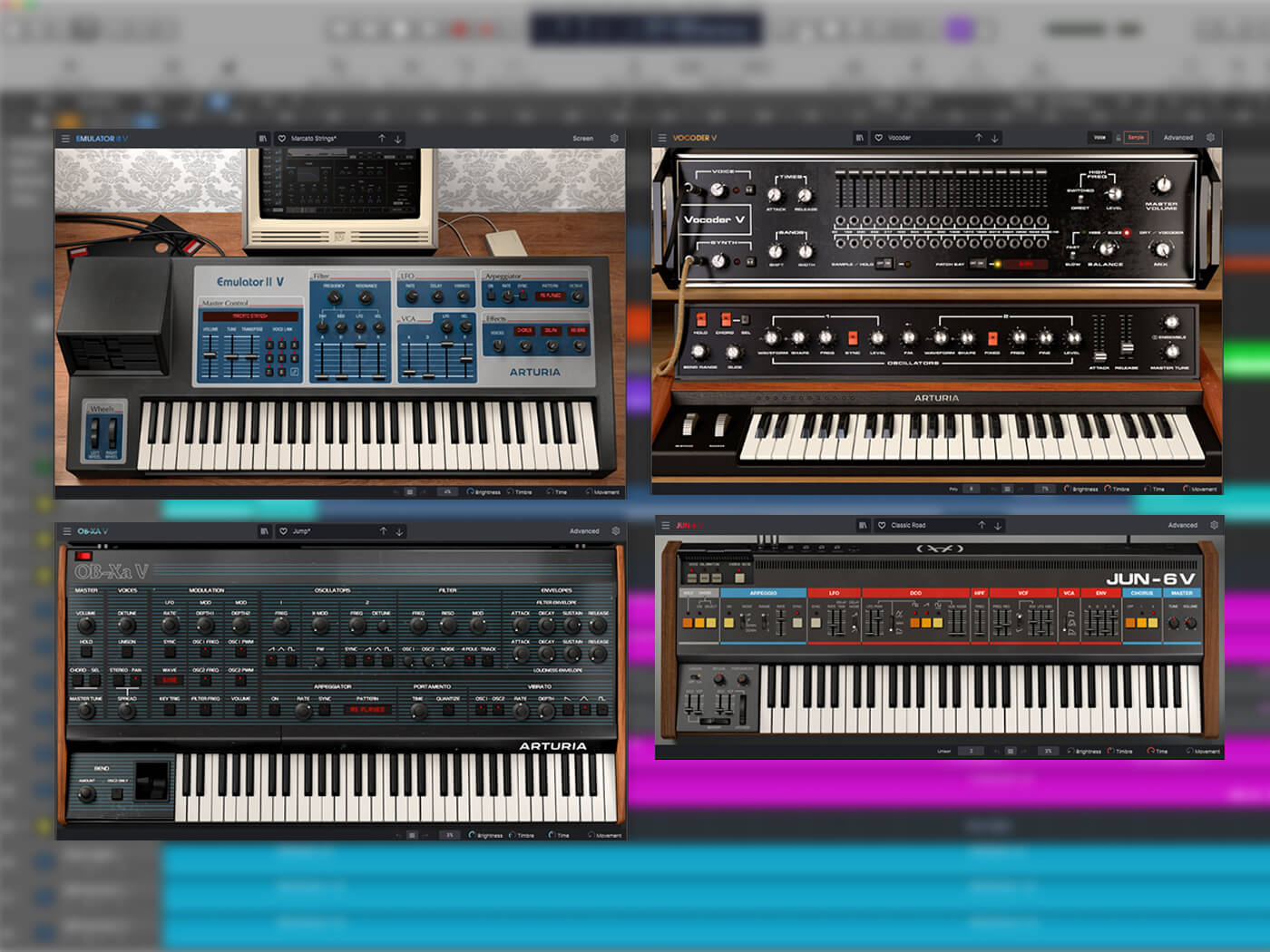Review: Arturia V Collection 8
The latest version of Arturia’s ever-popular vintage soft synth collection gains a vocoder, Juno-6, Emulator II and OB-Xa recreation, plus some nifty extras. Is it the king of softsynth collections?

Review Overview
Our rating
10
Our verdict
⊕ Jun-6 V voice calibration recreates analogue sound
⊕ OB-Xa V modulation is impressive
⊕ Vocoder V is fun to play and sounds great
⊕ In-app tutorials get you tweaking faster
⊖ Vocoder V sidechain doesn’t work in Studio One and FL Studio
V Collection 8 ticks all the analogue and digital boxes. With the addition of a vintage sample library, vocoder and two iconic synths, this is a must-have for anyone chasing the vintage synth sound.

Price £439/$599 ($499 intro) Full version, £256/$349 Upgrade
Contact Arturia
With the revival of interest in vintage synth sounds, there’s a drive to create plug-in emulations of the most iconic classic instruments – and competition is fierce. So, Arturia has released V Collection 8, a collection of 28 virtual instruments. The new edition adds four new instruments and a new curated collection of patches.
Highlights already included emulations of the ARP 2600, CMI Fairlight, Yamaha CS-80, Roland Jupiter-8 and Minimoog. But there’s also Synthopedia – an 800-patch sound bank of fresh sounds for Analog Lab V.
We thought it couldn’t possibly get any better than this staggering collection of vintage instruments (and wealth of patches). However, Arturia gives you all that and adds Emulator II V, Jun-6 V, OB-Xa V and Vocoder V, as well as reworked versions of Jup-8 V, Stage-73 V and Analog Lab. They’ve also added yet another sound bank in the form of PatchWorks: a 700-patch library of sounds for Analog Lab V.
Emulator II V
If you’ve ever seen Ferris Bueller’s Day Off or listened to more than 30 minutes of 80s music, you’ve heard this sampling monster. The Emulator II’s 8-bit sampling goodness and factory library were used by too many 80s artists to count.
This emulation (pun intended) recreates that crunchy lo-fi sound. It includes some patches from the original factory library and some modern sounds to get the creative juices flowing. The front panel features the most commonly required controls such as filter, LFO and VCA. Arturia’s version adds a few front panel functions absent from the original, such as the effects and arpeggiator sections. The arpeggiator is a basic but functional affair. It includes several standard modes (up, down, up&down, random, etc.) and rate, sync and octave controls.
You can access more controls by clicking the monitor above the EII. Here, you can quickly build or edit your drum kits and sample instruments. You can edit sample start and end points, play direction, filters and LFOs, add effects, assign different samples to different key groups and trig delay.
The output section of the editor is worthy of special mention, too. Not only can you adjust the polyphony from monophonic up to 32 notes, but you can also switch the DAC from Vintage to Modern. And thanks to the new synth-specific tutorials, playing and learning EII V is extremely intuitive.
The 250 patches are pretty good as well. For 80s traditionalists, there are some patches from the original Emulator library, alongside many modern sounds that will be useful in current productions, including some Roland TR series drum kits.
Jun-6 V
The Jun-6 V is based on Roland’s Juno-6, a polyphonic synth that’s still highly coveted today. Jun-6 V features over 180 patches that showcase the Jun-6’s warm and toasty sound. The DCOs sound both warm and crunchy, and bright and sparkly. Like its hardware counterpart, it’s very flexible indeed.
The clean interface includes a DCO with square, sawtooth, sub-oscillator and noise. There’s also an LFO, high-pass filter and Voltage Controlled Filter for shaping your sound. Finally, there’s a VCA with a standard ADSR envelope. One of the exciting inclusions here is the classic Chorus that made the Juno series famous.
There’s an arpeggiator for adding movement. Adding the hold button will set off a bubbling riff while you tweak your sound. There’s also a Chord feature for creating one-note chords. A voice calibration mode lets you choose between good, fair and poor calibration. Voice calibration is a fantastic inclusion and gives the Jun-6 V an incredibly realistic analogue character. Understanding that each quirk of the original hardware contributes to the vintage vibe, there’s even a button to turn on the chorus module’s characteristic noise.
In advanced controls, you’ll find an extra LFO, another envelope, and a small modulation matrix for assigning the mod wheel, velocity, and aftertouch to several destinations. Arturia also understands the importance of built-in effects and has added delay and reverb units to sweeten the sound. Juno what? It sounds great!
OB-Xa V
The Oberheim sound finally comes to V Collection in the shape of the OB-Xa V, a 16-voice polyphonic synth with two oscillators and blendable noise. The oscillators have that classic bite and growl that is so characteristic of Oberheim synths. It’s also competent for modulation. As well as sporting a flexible modulation matrix, it also has an X-Mod control for modulating VCO 1’s frequency with VCO 2. OB-Xa’s stereo spread function is impressive, too, spreading the sound for wide stereo imaging. And the Pan button bounces sounds from left to right and back.
The Advanced button grants access to a slick modulation and effects section. The modulation section includes four Functions. These are bi-polar, variable-length function generators, and you can assign each to any parameter on OB-Xa V.
Meanwhile, the effects section includes the usual suspects from Reverb and Delay to Overdrive and a resonant Multimode Filter. There are three effects slots that you can run in series or parallel for more tonal options. Again, the idea is to create production-ready, playable sounds that inspire, all from V Collection 8.
Vocoder V
Vocoder V is based on a classic 16-band vocoder and includes a synth section, a sampler for playing pre-recorded samples, a chord mode feature and more.
There’s a simple mix section for blending the amount of voice input or synth input. There are also two knobs for adjusting the attack and release times of all bands. Sixteen sliders adjust the volume of each frequency band. The patchbay adds more tweakability. To keep things easy, the top row of jacks are modulators, and the bottom row are carriers to keep things easy. With the virtual patch cables, any modulator frequency can affect any carrier band. And each modulator can patch into up to three carrier bands for wild results.
The synth section is simple yet avoids the need for an external synth as a carrier. It features two oscillators with four waveforms to choose from. It also has one-knob FM synthesis functionality. The carrier synth sounds fine and does the trick for classic vocoder sounds.
Vocoder V has a sampler with 12 slots for preset samples from the factory library or your own custom samples from the user library or by drag-and-drop. While not a proper sampler, you can set start, end and loop points. You can also EQ and compression for samples and set playback direction.
The bottom line is that Vocoder V is fun to play and sounds great. And, although it works well with many modern DAWs, be warned, PreSonus Studio One 5 and FL Studio do not support sidechain audio inputs to an external plug-in instrument. As such, you can only play samples through Vocoder V – there is currently no way to route live audio through it (although you can record your own samples to import).
Beyond everything already covered, it’s worth mentioning V Collection 8’s new Tutorial system, which walks the user through each section of every instrument and shows how to get started using that particular instrument with examples. This makes learning the instruments and diving into sound experimentation very fast – another reason to dive in right now.
System Requirements
- Win 8.1+ (64-bit) / MacOS 10.13+
- 4 GB RAM, 2.5 GHz CPU
- 20GB free hard disk space
- OpenGL 2.0 compatible GPU
Key Features
- Includes 28 virtual instruments
- Synthopedia, 800-patch sound bank of modern sounds for Analog Lab
- Patch Works, 700-patch sound bank with classic and modern sounds
- Over 10,000 presets
- In-app tutorials for every instrument
- Analog Lab 5, Arp 2600 V, B-3 V, Buchla Easel V, Clavinet V, CMI V, CS-80 V, CZ V, DX7 V, Farfisa V, Jup-8 V, Matrix-12 V, Mellotron V, Mini V, Modular V, Piano V, Prophet V, SEM V, Solina V, Stage-73 V, Synclavier V, Synthi V, VOX Continental V, and Wurli V.
- Buy: Plugin Boutique, Sweetwater, Splice